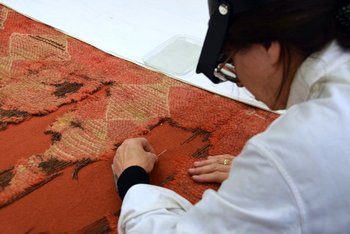The Korolnik Carpet
The fragment of a carpet is the only instance restored that depicts a birth scene. According to its former owner, member of a rehammna family (Oulad Izar), who donated the fragment to collector Annette Korolnik-Andersch and her husband Marcel Korolnik in that place in 1994, the rhomb rows symbolise labour contractions. Finally they bear the child in a birth scene, depicting a temporal procedure in a sequence of images. Over the past years this carpet and next to it a couple of older textiles decorated with henna paint have been given to the ethnographic museum in Dresden (MVD). This is due to the strong collaboration between Annette Korolnik-Andersch and the African collections curator at the museum, Silvia Dolz. One aim is to preserve this important treasure and realise an exhibition in the following years.
bild

text
Due to the desolate state, the carpet is in, and its relevance to the museums collections, we have chosen a restoration project large in scope, coninding with visiting scholar Durdane Gadirova stay in Dresden in 2018. She is head of conservation, restoration and prophylactic control at Azerbaidjan National Carpet Museum. During that period, Christine Müller-Radloff, textile restorator at MVD, and Durdane Gadirova jointly documented the state before the restoration and worked through a restoration concept. This contained the supporting blank spots and securing fragile bits with natural silk.
